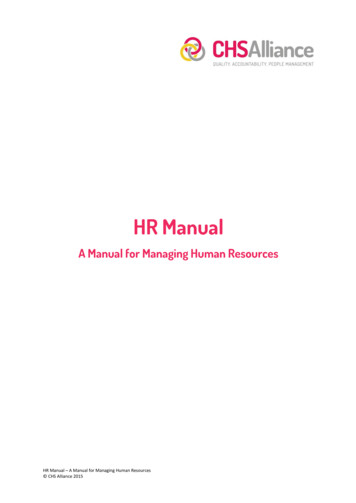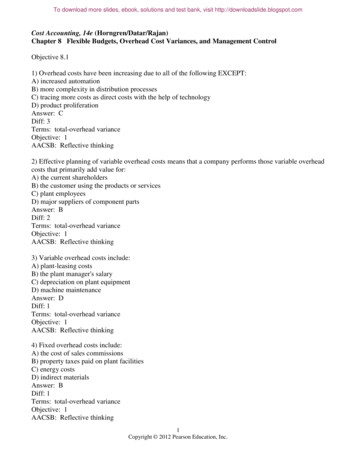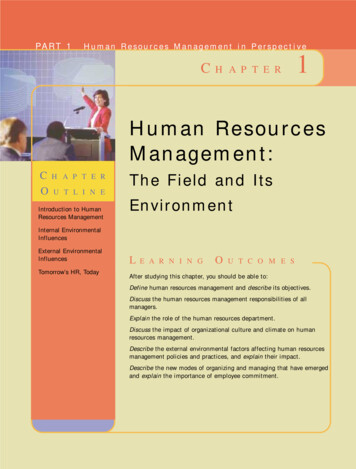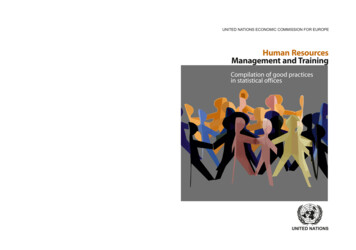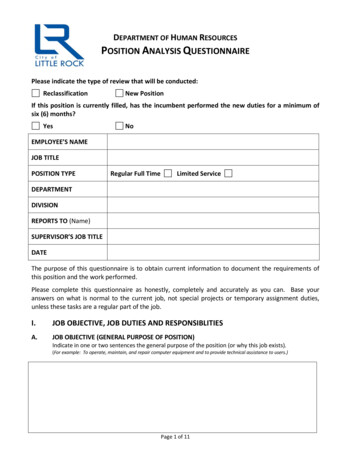
Transcription
PHOTODISC GREEN/GETTY IMAGESManaging Human Resources, 14e, Bohlander/Snell - 2007 Thomson South-Western
chapter7Training andDevelopmentand describe how they facilitatetraining.PART 3objective3Identify the principles of learningtraining-needs assessment.4Identify the types of trainingobjectiveobjective2Describe the components ofto training and development.5Discuss the advantages andobjectiveobjective1Discuss the systems approachobjectiveAfter studying this chapter, you should be able to6Describe the special trainingmethods used for managersand nonmanagers.disadvantages of variousevaluation criteria.programs that are currentlypopular.Developing Effectiveness in Human ResourcesManaging Human Resources, 14e, Bohlander/Snell - 2007 Thomson South-Western293
294PART 3Developing Effectiveness in Human Resourcesraining has become increasingly vital to the success of modernorganizations. Recall that in Chapter 2 we noted that organizationsoften compete on competencies—the core sets of knowledge andexpertise that give them an edge over their competitors. Trainingplays a central role in nurturing and strengthening these competencies, and in this way has become part of the backbone of strategy implementation. In addition, rapidly changing technologies require that employeescontinuously hone their knowledge, skills, and abilities (KSAs) to cope withnew processes and systems. Jobs that require little skill are rapidly beingreplaced by jobs that require technical, interpersonal, and problem-solvingskills. Other trends toward empowerment, total-quality management, teamwork, and international business make it necessary for managers, as well asemployees, to develop the skills that will enable them to handle new andmore demanding assignments.TThe Scope of TrainingMany new employees come equipped with most of the KSAs needed to start work.Others may require extensive training before they are ready to make much of a contribution to the organization. Almost any employee, however, needs some type of ongoing training to maintain effective performance or to adjust to new ways of work.The term training is often used casually to describe almost any effort initiated byan organization to foster learning among its members. However, many experts distinguish between training, which tends to be more narrowly focused and orientedtoward short-term performance concerns, and development, which tends to be oriented more toward broadening an individual’s skills for future responsibilities. Thetwo terms tend to be combined into a single phrase—training and development—torecognize the combination of activities organizations use to increase the skill base ofemployees.The primary reason that organizations train new employees is to bring their KSAsup to the level required for satisfactory performance. As these employees continue onthe job, additional training provides opportunities for them to acquire new knowledge and skills. As a result of this training, employees may be even more effective onthe job and may be able to perform other jobs in other areas or at higher levels.Investments in TrainingResearch shows that an organization’s revenues and overall profitability are positivelycorrelated to the amount of training it gives its employees. According to Trainingmagazine’s ongoing industry report, U.S. businesses spend more than 50 billionannually to provide each of their employees with twenty-six hours, on average, of formal training. By contrast, the 100 best U.S. companies to work for, as cited by Fortunemagazine in 2004, provide employees with nearly double that amount of training—forty-five hours, on average. While a good deal of money is spent on executive development and management training, Figure 7.1 shows that by far the greatest proportionof training is spent on rank-and-file employees and supervisors. Technology, trans-Managing Human Resources, 14e, Bohlander/Snell - 2007 Thomson South-Western
CHAPTER 7295Training and DevelopmentFigure 7.1Training Dollars Spent by Employee Type 19.8(39%)Training Dollars Spent by Employee Type(in billions of dollars) 2015 12.6(25%) 12.4(24%)ManagersSupervisors10 6.5(13%)50ExecutivesEmployeesSource: Holly Dolezalek, “2004 Industry Report,” Training (October 2004): 28.objectiveportation, communications, and utilities industries tend to spend the most on training. In addition to the more than 50 billion spent by U.S. businesses each year onformal training, nearly four times that amount is spent on informal instruction. Thetypes of training given employees range from simple, on-the-job instruction tosophisticated skills training conducted on multimillion-dollar simulators. Othertypes of training include customer service, sales and management training, personalgrowth, and communication skills training.11A Systems Approach to TrainingFrom the broadest perspective, the goal of training is to contribute to the organization’soverall goals. Training programs should be developed with this in mind. Managersshould keep a close eye on organizational goals and strategies and orient trainingaccordingly. Unfortunately, many organizations never make the connection betweentheir strategic objectives and their training programs. Instead, fads, fashions, or“whatever the competition is doing” can sometimes be the main drivers of an organization’s training agenda. As a result, much of an organization’s investment can bewasted—training programs are often misdirected, poorly designed, and inadequatelyevaluated—and these problems directly affect organizational performance.Managing Human Resources, 14e, Bohlander/Snell - 2007 Thomson South-Western
296PART 3Developing Effectiveness in Human ResourcesTo ensure that investments in training and development have maximum impacton individual and organizational performance, a systems approach to training shouldbe used. The systems approach involves four phases: (1) needs assessment, (2) program design, (3) implementation, and (4) evaluation. A model that is useful todesigners of training programs is presented in Figure 7.2. We will use this model as aframework for organizing the material throughout this chapter.objectivePhase 1: Conducting the Needs AssessmentManagers and HR staffs should stay alert to the kinds of training that are needed,where they are needed, who needs them, and which methods will best deliver neededKSAs to employees. If workers consistently fail to achieve productivity objectives, thismight be a signal that training is needed. Likewise, if organizations receive an excessive number of customer complaints, this too might suggest inadequate training. Tomake certain that training is timely and focused on priority issues, managers should2Figure 7.2Systems Model of TrainingPHASE 4:EvaluationPHASE 3:ImplementationPHASE 2:DesignPHASE 1:Needs Assessment Organizationanalysis Task analysis Person analysis Instructionalobjectives Traineereadiness Learningprinciples On-the-jobmethods Off-the-jobmethods Managementdevelopment Reactions Learning Behavior (transfer) ResultsNote:U.S. organizations spend more than 50 billion annually on training.Much of that investment iswasted because it is not donein a systematic way.Managing Human Resources, 14e, Bohlander/Snell - 2007 Thomson South-Western
CHAPTER 7Training and Development297approach needs assessment systematically by utilizing the three different types ofanalysis shown in Figure 7.3: organization analysis, task analysis, and person analysis.Each of these is discussed next.To ensure that their firms’ training dollars are spent wisely, about half of managers surveyed by the Institute of Management and Administration (IOMA) say theircompanies engage in needs assessment before initiating a training program. Butmuch of the money spent on training still goes wasted. A separate study by theAmerican Society for Training and Development (ASTD) found that, unfortunately,because of the costs, expertise, and time required, organizations conduct needs assessment less than 50 percent of the time. Ironically, as the speed of change increases, andtime and resources are at a premium, the need for good needs assessment actuallyincreases. In these cases, the process need not be so daunting and laborious. Highlights in HRM 1 provides some tips for rapidly assessing training needs.2Organization Analysisorganization analysisExamination of the environment, strategies, andresources of the organization to determine wheretraining emphasis shouldbe placedFigure 7.3The first step in needs assessment is identifying the broad forces that can influencetraining needs. Organization analysis is an examination of the environment, strategies, and resources of the organization to determine where training emphasis shouldbe placed.Economic and public policy issues influence training needs. For example, sincethe September 11 attacks, the training of airport security personnel has increased substantially. It has also increased for flight crews of airlines, employees in the transportation industry, workers in nuclear power plants, and even security staff at theme parks.According to Chris Rogers, senior consultant for loss control in the Entertainment Practices Group of Aon Corporation (a risk management firm), there is anemphasis today on training theme park security in a tactic called “aggressive hospitality,” which calls for staff to greet people and look them in the eye and offer toassist, rather than waiting to be approached by visitors. “This is one of the best andsimplest security measures,” he says. When staff members engage visitors, theybecome more aware of them. This heightened level of attention also discouragestroublemakers from coming to the facility, because they generally go where they canremain anonymous.3Needs Assessment for Training ORGANIZATION ANALYSIS of environment, strategies, and resourcesto determine where to emphasize training. TASK ANALYSIS of the activities to be performed in orderto determine the KSAs needed. PERSON ANALYSIS of performance, knowledge, and skills inorder to determine who needs training.Managing Human Resources, 14e, Bohlander/Snell - 2007 Thomson South-Western
298PART 3Developing Effectiveness in Human ResourcesHighlights in HRM 1Notes on Rapid Needs AssessmentNOTE 1: Look at the problem scope. Common sense suggests that small, local mattersmay require less information gathering than big problems with a major impact on the organization. Ask managers a series of questions about the nature of the problem and its impact onthe organization and gear your analysis accordingly.NOTE 2: Do organizational scanning. Stay connected with what is going on in the organization in order to anticipate upcoming training needs. If a new technology is about to belaunched, the need for training should take no one by surprise. In short, needs assessment isn’tan event with a start-and-stop switch. It is the process of being engaged in your business.NOTE 3: Play “give and take.” Get the information you need, but don’t drag your feet withexcessive analysis before reporting back to managers. Show them that you are sensitive totheir need for action by giving them updates on the information you have collected. If necessary, explain that better value may be gained by further analysis.NOTE 4: Check “lost and found.” Often, information gathered for a different purpose maybear on your training issue. Performance data (such as errors, sales, and customer complaints) and staffing data (such as proficiency testing, turnover, and absenteeism) can be veryhelpful as a starting point.NOTE 5: Use plain talk. Instead of using clinical terms such as analysis or assessment, usestraight talk with managers that tells them what you are doing: (1) Identify the problem, (2) identify alternative ways to get there, (3) implement a solution based on cost/benefit concerns, and(4) determine the effectiveness and efficiency of the solution.NOTE 6: Use the Web. Information technology allows you to communicate with others, perhaps by setting up an electronic mailing list to post questions, synthesize responses, shareresources, get feedback, gather information on trends, and the like.NOTE 7: Use rapid prototyping. Often the most effective and efficient training is that whichis “just-in-time, just enough, and just for me.” Create a rapid prototype of a training program,evaluating and revising as you implement and learn more about the problems.NOTE 8: Seek out exemplars. Find those in the organization that currently demonstrate theperformance the organization wants. Bring others together with them to talk about the performance issues, and let the exemplars share their experiences and insights. This avoids therisk of packaging the wrong information, and people learn just what they need to know fromeach other.Source: Condensed from Ron Zemke, “How to Do a Needs Assessment When You Think You Don’t HaveTime,” Training 35, no. 3 (March 1998): 38–44. Reprinted with permission from the March 1998 issue ofTraining Magazine. Copyright 1998. Bill Communications, Inc., Minneapolis, MN. All rights reserved. Notfor resale.Managing Human Resources, 14e, Bohlander/Snell - 2007 Thomson South-Western
RICHARD NOWITZ/CORBISCHAPTER 7A company must carefullyanalyze the job duties ofits employees to determine their training needs.Training and Development299Other training issues tend to revolve around thestrategic initiatives of an organization. Mergers andacquisitions, for example, frequently require thatemployees take on new roles and responsibilities andadjust to new cultures and ways of conducting business.Nowhere is this more prevalent than in grooming newleaders within organizations. Other issues such as technological change, globalization, reengineering, and totalquality management all influence the way work is doneand the types of skills needed to do it. Still other concerns may be more tactical, but no less important intheir impact on training. Organizational restructuring,downsizing, empowerment, and teamwork, for example,have immediate training requirements. Finally, trends inthe workforce itself have an impact on training needs.As older workers near retirement, younger workers needto focus on gaining the skills and knowledge needed totake their place. Organizations as diverse as Intel andBoeing are facing situations in which they need to prepare the next generations of employees as the currentgroups approach retirement.Side by side with forces that influence trainingneeds, organization analysis involves close examinationof the resources—technological, financial, and human—that are available to meet training objectives. Organizations typically collect data to use in the analysis, datasuch as information on direct and indirect labor costs,quality of goods or services, absenteeism, turnover, and number of accidents. Theavailability of potential replacements and the time required to train them are otherimportant factors in organization analysis.In recent years, as organizations continue to keep a tight rein on costs, trainingbudgets are often constrained—even while organizations recognize the need for moreand better training. To cope with resource constraints while contributing to strategicimperatives, managers have to be more focused and efficient with their trainingbudgets. Companies such as Motorola, Ford, and Merck have found that by usinginformation technology wisely, they cut their training budget by as much as 30 to 50percent while keeping service levels high. In order to “do more with less,” managershave to plan carefully where they will spend their training dollars, and this meansdoing rigorous organization analysis. Other companies have outsourced their training programs to external partners in order to cut costs. However, evidence suggeststhat while many companies find they can provide equal or better service to employees in this way, surprisingly few actually reduce their training costs as a result.4task analysisThe process of determining what the content of atraining program shouldbe on the basis of a studyof the tasks and dutiesinvolved in the jobTask AnalysisThe second step in training-needs assessment is task analysis. Task analysis involvesreviewing the job description and specifications to identify the activities performedin a particular job and the KSAs needed to perform them. Task analysis oftenManaging Human Resources, 14e, Bohlander/Snell - 2007 Thomson South-Western
300PART 3competency assessmentAnalysis of the sets ofskills and knowledgeneeded for decisionoriented and knowledgeintensive jobsDeveloping Effectiveness in Human Resourcesbecomes more detailed than job analysis, but the overall purpose is to determine theexact content of the training program.The first step in task analysis is to list all the tasks or duties included in the job.The second step is to list the steps performed by the employee to complete each task.Once the job is understood thoroughly, the type of performance required (such asspeech, recall, discrimination, and manipulation), along with the skills and knowledge necessary for performance, can be defined. For example, in the task of taking achest x-ray, a radiologist correctly positions the patient (manipulation), gives specialinstructions (speech), and checks the proper distance of the x-ray tube from thepatient (discrimination). The types of performance skills and knowledge that traineesneed can be determined by observing and questioning skilled jobholders and/or byreviewing job descriptions. This information helps trainers select program contentand choose the most effective training method.However, like job analysis, task analysis appears to be shifting from an emphasison a fixed sequence of tasks to the more flexible sets of competencies required forsuperior performance. Companies such as Case Financial and the Principal FinancialGroup have found that as jobs change toward teamwork, flexibility requires thatemployees adjust their behavior as needed. Competency assessment focuses on thesets of skills and knowledge employees need to be successful, particularly for decision-oriented and knowledge-intensive jobs. But competency assessment goesbeyond simply describing the traits an employee must have to successfully performthe work. It also captures elements of how those traits should be used within anorganization’s context and culture. That might include an employee’s motivation levels, personality traits, interpersonal skills, and so on. General Electric, for example,uses a formal competency assessment program based on forty-five different employeebehaviors. While training programs based on work-oriented task analysis canbecome dated as work undergoes dynamic change, training programs based on competency assessment are more flexible and perhaps have more durability. The practicehas been adopted extensively in the healthcare industry. Highlights in HRM 2 showsan example of a competency assessment used for designing training programs forpublic health professionals. The American Public Human Services Association hasadopted the model as an infrastructure for training universal skills.5Person Analysisperson analysisDetermination of thespecific individuals whoneed trainingAlong with organization and task analyses, it is necessary to perform a person analysis. Person analysis involves determining which employees require training and,equally important, which do not. In this regard, person analysis is important for several reasons. First, thorough analysis helps organizations avoid the mistake of sendingall employees into training when some do not need it. In addition, person analysishelps managers determine what prospective trainees are able to do when they entertraining so that the programs can be designed to emphasize the areas in which theyare deficient.Companies such as Teradyne and Hewlett-Packard have used performanceappraisal information as an input for person analysis. However, while performanceappraisal may reveal who is not meeting expectations, it typically does not revealwhy. If performance deficiencies are due to ability problems, training may likely be agood intervention. However, if performance deficiencies are due to poor motivationor factors outside an employee’s control, training may not be the answer. UltimatelyManaging Human Resources, 14e, Bohlander/Snell - 2007 Thomson South-Western
CHAPTER 7Training and Development301Highlights in HRM 2Competency Assessment for TrainingPublic Health Workers Analytic disciplineDetermining appropriate use of data and statistical methodsMaking relevant inferences from data Communication disciplineCommunicating effectively both in writing and orallyPresenting accurately and effectively demographic, statistical, programmatic, andscientific information for professional and lay audiences Policy and program-planning disciplineDeveloping mechanisms to monitor and evaluate programs (effectiveness, quality) Culture disciplineDeveloping and adapting approaches that take into account cultural differences Basic science disciplineUnderstanding research methods in all basic public health sciencesApplying the basic public health sciences, including behavioral and social sciences,biostatistics, epidemiology, environmental public health, and prevention of chronicand infectious diseases and injuries Finance and management disciplineMonitoring program performance Orientation to public healthPublic health processCore functions and essential servicesEthics and values of public healthLegal basis of public healthSource: Margaret Potter, Christine Pistella, Carl Fertman, and Virginia Dato, “Needs Assessment and aModel Agenda for Training the Public Health Workforce,” American Journal of Public Health 90, no. 8(August 2000): 1294–96. Reprinted by permission of American Public Health Association.managers have to sit down with employees to talk about areas for improvement sothat they can jointly determine the developmental approaches that will have maximum benefit.6Phase 2: Designing the Training ProgramOnce the training needs have been determined, the next step is to design the type oflearning environment necessary to enhance learning. The success of training programs depends on more than the organization’s ability to identify training needs.Managing Human Resources, 14e, Bohlander/Snell - 2007 Thomson South-Western
302PART 3Developing Effectiveness in Human ResourcesSuccess hinges on taking the information gained from needs analysis and utilizing itto design first-rate training programs. Experts believe that training design shouldfocus on at least four related issues: (1) instructional objectives, (2) trainee readinessand motivation, (3) principles of learning, and (4) characteristics of instructors.Instructional Objectivesinstructional objectivesDesired outcomes of atraining programAs a result of conducting organization, task, and person analyses, managers will havea more complete picture of the training needs. On the basis of this information, theycan more formally state the desired outcomes of training through written instructional objectives. Generally, instructional objectives describe the skills or knowledgeto be acquired and/or the attitudes to be changed. One type of instructional objective, the performance-centered objective, is widely used because it lends itself to anunbiased evaluation of results. For example, the stated objective for one training program might be that “Employees trained in team methods will be able to performthese different jobs within six months.” Performance-centered objectives typicallyinclude precise terms, such as “to calculate,” “to repair,” “to adjust,” “to construct,” “toassemble,” and “to classify.”Robert Mager, an internationally known training expert, emphasizes the importance of instructional objectives by noting that “before you prepare for instruction,before you select instructional procedures or subject matter or material, it is important to be able to state clearly just what you intend the results of that instruction tobe. A clear statement of instructional objectives will provide a sound basis for choosing methods and materials and for selecting the means for assessing whether theinstruction will be successful.”7Trainee Readiness and MotivationTwo preconditions for learning affect the success of those who are to receive training:readiness and motivation. Trainee readiness refers to both maturity and experiencefactors in the trainee’s background. Prospective trainees should be screened to determine that they have the background knowledge and the skills necessary to absorbwhat will be presented to them. Recognizing individual differences in readiness is asimportant in organizational training as it is in any other teaching situation. It isoften desirable to group individuals according to their capacity to learn, as determined by test scores, and to provide an alternative type of instruction for those whoneed it.The receptiveness and readiness of participants in training programs can beincreased by having them complete questionnaires about why they are attendingtraining and what they hope to accomplish. Participants may also be asked to givecopies of their completed questionnaires to their managers.The other precondition for learning is trainee motivation. Individuals who areconscientious, goal-oriented, self-disciplined, and persevering are more likely to perceive a link between effort they put into training and higher performance on the job.For optimum learning to take place, trainees must recognize the need for newknowledge or skills, and they must maintain a desire to learn as training progresses.By focusing on the trainees themselves rather than on the trainer or training topic,managers can create a training environment that is conducive to learning. Six strategies can be essential:Managing Human Resources, 14e, Bohlander/Snell - 2007 Thomson South-Western
CHAPTER 71.2.3.4.5.6.Training and Development303Use positive reinforcement.Eliminate threats and punishment.Be flexible.Have participants set personal goals.Design interesting instruction.Break down physical and psychological obstacles to learning.objectiveWhile most employees are motivated by certain common needs, they differ from oneanother in the relative importance of these needs at any given time. For example,new college graduates often have a high desire for advancement, and they have established specific goals for career progression. Training objectives should be clearlyrelated to trainees’ individual needs to succeed in training programs.83Principles of LearningAs we move from needs assessment and instructional objectives to employee readinessand motivation, we shift from a focus on the organization to a focus on employees.Ultimately, training has to build a bridge between employees and the organization.One important step in this transition is giving full consideration to the psychologicalprinciples of learning—that is, the characteristics of training programs that helpemployees grasp new material, make sense of it in their own lives, and transfer itback to the job.Because the success or failure of a training program is frequently related to certain principles of learning, managers as well as employees should understand thatdifferent training methods or techniques vary in the extent to which they utilizethese principles. All things considered, training programs are likely to be more effective if they incorporate the principles of learning shown in Figure 7.4.Goal SettingThe value of goal setting for focusing and motivating behavior extends into training.When trainers take the time to explain the goals and objectives to trainees—or whentrainees are encouraged to set goals on their own—the level of interest, understanding,and effort directed toward training is likely to increase. In some cases, goal settingcan simply take the form of a “road map” of the course/program, its objectives, andits learning points.9Meaningfulness of PresentationOne principle of learning is that the material to be learned should be presented in asmeaningful a manner as possible. Quite simply, trainees are better able to learn newinformation (from training) if they can connect it with things that are already familiar to them. Trainers frequently use colorful examples to which trainees can relate.The examples make the material meaningful. In addition, material should be arrangedso that each experience builds on preceding ones. In this way, trainees are able tointegrate the experiences into a usable pattern of knowledge and skills.ModelingThe old saying “A picture is worth a thousand words” applies to training. Just asexamples increase the meaningfulness of factual material or new knowledge in atraining environment, modeling increases the salience of behavioral training. Work byManaging Human Resources, 14e, Bohlander/Snell - 2007 Thomson South-Western
304PART 3Developing Effectiveness in Human ResourcesFigure 7.4Principles of aningfulnessof presentationPRINCIPLESOF LEARNINGFeedbackand reinforcementActive practiceand repetitionWhole-versuspart learningMassed-versusdistributed learningAlbert Bandura and others on social learning theory underscores the point that welearn vicariously. Quite simply, we learn by watching. For example, if you were learning to ride a horse, it would be much easier to watch someone do it—and then try ityourself—than to read a book or listen to a lecture and hope you can do it right.10Modeling can take many forms. For example, real-life demonstrations or videotapes are often helpful; even pictures and drawings can get the visual message across.The point is that modeling demonstrates the desired behavior or method to belearned. In some cases, modeling the wrong behavior can even be helpful if it showstrainees what not to do and then clarifies the appropriate behavior.Individual Differenc
opment and management training, Figure 7.1 shows that by far the greatest proportion of training is spent on ra

